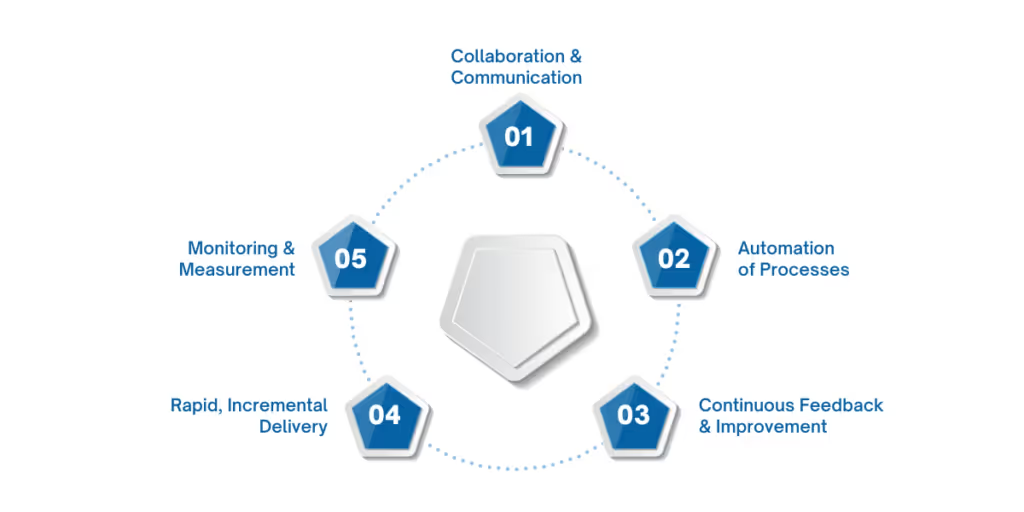


Think of software development as a well-coordinated team, where every part —every line of code—works seamlessly together. In this environment, Continuous Integration (CI) and DevOps Automation help developers, testers, and operations teams collaborate efficiently, enabling the creation of high-quality, bug-free applications at an accelerated pace.
In the past, integration issues, long delays, and manual processes were the norm in software development. Thanks to CI, developers now merge their code frequently, allowing for quick feedback and early detection of errors. CI tests and validates each small change, setting the stage for DevOps Automation.
DevOps automation accelerates the process, automating testing, deployment, and operations—reducing human error, and speeding up the journey from idea to release. When CI and DevOps automation work together, they form a powerful synergy that transforms development practices, boosting efficiency and innovation.
Since the DevOps market is projected to expand from $11.5 billion in 2023 to $66.0 billion by 2033, it’s essential to know how CI and DevOps automation enhance development. This article explores everything about that. Let's first look at how the core principles of DevOps align with Continuous Integration.

The DevOps market in North America accounted for 38.5% of the global market share in 2023. Thus, it is more than just tools or practices—it's a cultural shift that bridges the gap between development and operations teams, encouraging collaboration, shared responsibility, and continuous improvement. CI is one of the cornerstones of this movement, enabling faster, more reliable software delivery. When CI practices align with DevOps principles, teams unlock greater value in their development pipelines.
Breaking down silos between teams is key in DevOps. Developers, operations, and Quality Assurance (QA) teams share responsibility for the software lifecycle. CI fosters collaboration by integrating code regularly into a shared repository, ensuring all team members stay aligned. By committing small changes frequently, CI minimizes integration conflicts and promotes better communication.
DevOps relies on automating repetitive tasks to speed up the delivery pipeline and reduce human error. CI thrives on this by automating code integration—running unit tests, building projects, and notifying teams of any issues. This automation extends across the entire process, enabling teams to focus on higher-value tasks.
CI exemplifies DevOps' principle of continuous feedback. With each integration and test, developers receive immediate insights into the health of the codebase, allowing them to identify issues early. This real-time feedback helps teams make incremental improvements, reducing the time and cost of addressing issues at later stages.
CI accelerates software delivery by encouraging small, frequent code changes. Each integration is automatically built and tested, ensuring that every new feature, bug fix, or change is validated quickly. This rapid delivery process ensures that software is always in a deployable state, enabling faster, more reliable releases.
DevOps emphasizes the importance of monitoring to ensure software reliability and performance. CI contributes by providing valuable metrics like build success rates, test results, and code quality reports. These insights help teams monitor project health in real time, identify areas for improvement, and ensure stability throughout development.
As we now understand, CI not only fosters collaboration and automation but also provides the foundation for modern development practices. Let’s dive deeper into how CI serves as this critical foundation.
Approximately 61.21% (132,180) of companies utilizing DevOps services are based in the United States.
CI is the practice of merging code changes frequently into a shared repository, where they are automatically built and tested. This foundation minimizes risks associated with traditional larger-scale releases by catching integration issues early and ensuring the software remains in a deployable state. Here’s why CI is essential to modern development:
CI offers an early warning system for potential problems. By integrating and testing code frequently, issues are caught quickly—much sooner than in traditional development cycles, where bugs might not be identified until later stages. This early feedback helps teams resolve issues promptly and reduces debugging time.
With continuous integration and testing, teams can maintain high quality throughout development. Automated tests run with each integration to prevent regressions or broken functionality. This constant vigilance fosters robust, reliable software and reduces the need for costly manual testing.
CI speeds up the software delivery cycle by allowing for faster, more predictable releases. Since code is tested and integrated in smaller, more manageable increments, teams can deploy new features or fixes as soon as they’re validated, ensuring quicker feedback loops and smoother transitions from development to production.
By integrating code frequently, CI prevents integration conflicts that often arise when developers work in isolation. This fosters a collaborative environment, with team members consistently sharing code and ideas, leading to more effective teamwork and accountability.
Automation ensures consistent execution of tasks like building, testing, and deploying. This reduces human error and speeds up repetitive tasks, allowing developers to focus on more creative work. With automated tools, teams ensure that each integration is handled reliably and consistently, boosting overall quality.
Now that we’ve seen how automation boosts efficiency, it’s time to look at the specific tools that help make this automation possible.
Also Read: Top DevOps Tools for Infrastructure Automation in 2025
Automation is a key driver of CI, eliminating manual intervention in tasks like integration, testing, and building. By automating these tasks, CI boosts efficiency and consistency, allowing developers to focus on coding. Let’s explore how automation works within CI and some essential tools that help bring it to life.
Several tools automate the testing and building of software within the CI pipeline, ensuring code changes are efficiently tested and built with minimal manual intervention:
Tools for Automating Building:
Tools for Automating Testing:
Processes for Automation in CI:
These tools and processes significantly improve development efficiency and quality. In the next section, let’s have a look at some of the benefits of integrating CI with DevOps automation.

Combining CI with DevOps Automation accelerates software development, enhances quality, and improves speed. Together, they create a continuous delivery pipeline that maximizes efficiency. Here are some major benefits:
CI integrates and tests code frequently, while DevOps Automation streamlines deployment and operational tasks. This enables teams to move from development to production more quickly, delivering features and fixes faster.
Automating integration with CI ensures regular testing and validation, while DevOps Automation streamlines testing, building, and deployment. This early detection of issues results in higher-quality, stable code.
CI, combined with DevOps Automation, removes friction between development and operations teams by automating deployment and infrastructure provisioning. This shared responsibility leads to smoother transitions between stages of development.
Automation reduces human error, ensuring that processes like testing and deployment are executed consistently. This leads to a more reliable software pipeline and smoother production environments.
Integrating CI with DevOps Automation helps detect issues early through continuous testing and integration. Automation ensures that problems are addressed promptly, reducing risks and ensuring higher-quality software.
It’s important to note that while automation brings numerous benefits, it also presents challenges that organizations must be prepared to navigate. Let’s explore some of these challenges and considerations.
Also Read: DevOps vs. SRE: Differences in Speed and Reliability
While the integration of CI and DevOps Automation offers numerous benefits, it also presents challenges:
Integrating Continuous Integration (CI) with DevOps automation is crucial for achieving efficient and reliable software delivery. This integration provides several key advantages that address the challenges of modern software development, including the need for speed, quality, and collaboration. By continuously integrating code and automating the entire software lifecycle, teams can detect issues early, ensure code quality, and speed up deployment cycles.
Adopting CI and DevOps automation is not just about implementing specific tools or practices—it's about embracing a culture of continuous improvement and innovation. As the tech landscape becomes increasingly dynamic, businesses must adapt quickly to stay competitive. CI and DevOps provide the infrastructure and processes that empower teams to deliver features, fixes, and updates at an accelerated pace, with higher quality and less risk.
At WaferWire, we understand how Continuous Integration and DevOps automation can streamline your development processes and drive faster, more reliable software delivery. Let WaferWire help you design, implement, and manage a robust CI and DevOps framework that aligns with your business goals, empowering your team to harness the full potential of automation and collaboration. Let’s build a more efficient, data-driven, and agile organization together. Get in touch today!

